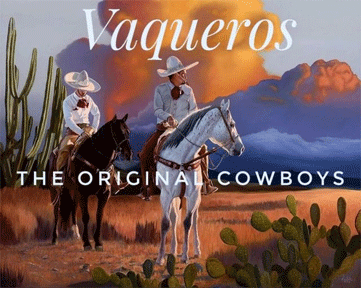The History Of The Vaquero: Mexican vaqueros inspired the American cowboy
News Category: News and General Discussion
-
Rooted in necessity and shaped by the land, the Mexican cowboy tradition influenced the origin of cowboys in the west
by Efrain Gonzales
1519–1700s After the Spanish arrived in Mexico in 1519, ranches were established and stocked with cattle and horses imported from Spain. Landowners mounted native Indians on well-trained horses and taught them to handle cattle. By the early 1700s, cattle ranching had spread north into what is now Texas, Arizona, and New Mexico and south to Argentina. The native cowboys were called vaqueros (from the Spanish word for cow) and developed roping skills, using braided rawhide reatas (the root word for lariat).
Starting in 1769, a chain of 21 Franciscan missions eventually stretched from San Diego to San Francisco, marking the beginning of California’s livestock industry.
Mid–1700s to 1820s Livestock production flourished in California and the Southwest, but few markets existed for end products such as meat, hides, and tallow (for making candles). By the mid-1700s, long trains of pack mules would transport these products to Mexico City and return with supplies. American ships began servicing California ports in the early 1800s and traded for the same materials. For the first time, ranchers had local markets for their animals. Huge roundups were held to collect cattle, and the hard-riding vaqueros controlled the chaos. Known for expert horsemanship and roping skills, vaqueros were said to only dismount for a chance to dance with pretty girls.
Early and mid-1800s Ranching ceased to be a strictly Hispanic profession as more Americans poured into once Mexican-held lands (especially after the Mexican/American War, 1846–48). The Anglo newcomers adapted to the vaquero style, and many settlers intermarried with the old Spanish ranching families. The 1849 gold rush brought even more people to California, which increased the demand for beef. Californios rode ponies that had been trained in a hackamore, swung a big loop with their hand-braided rawhide reatas, and took a wrap called a dally (from the Spanish dar la vuelta, to take a turn) around high saddle horns for leverage when roping cattle.
Late 1800s As the livestock industry expanded, these horsemen found work in Oregon, Idaho, Nevada, Arizona, and Hawaii, taking their equipment and livestock-handling techniques with them. Cowboys in Oregon, Idaho, and Nevada remained strongly Hispanic (“buckaroo” comes from vaquero), including the use of a center-fire rigged saddle, in which rigging is situated below the centerpoint of the saddle; a long reata; and silver-mounted spade bits.
Trail-driving Texans adopted many of their techniques from Mexican vaqueros, carrying their methods with them north through the Plains states and leading to a subculture of single, itinerant men who worked at ranches.
Today As long as cattle are raised in big American pastures, the legacy of the vaquero will endure. The early Mexican techniques for handling cattle can be seen throughout the modern livestock industry, like whenever a cowboy cinches a saddle on his horse, straps on chaps (from chaparreras, Spanish for leather leggings), competes in a rodeo (from rodear, Spanish for to surround), or ropes a horse from his remuda (from remudar, Spanish for exchange). Even branding migrated north from Mexico. On the Pacific Coast and on Nevada ranches, buckaroos still carry long ropes (nylon these days), ride slick-fork saddles, and use silver-mounted spade bits and spurs.
Por Efrain Gonzalez
Deseño Efrain Gonzalez


Leave a Reply